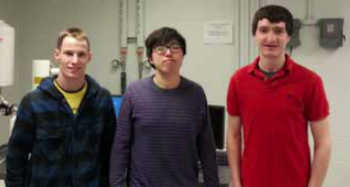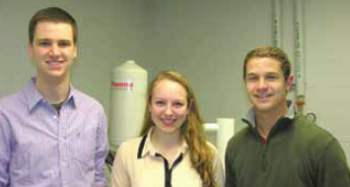Materials Science
Projects
Marten Sight: Failed Eyeglass Frame
The sample that failed is the frame of eyeglasses that was manufactured from multiple alloys. However, the exact type of alloy used on the failed part remains unknown. The condition and amount of loading applied to the parts that led to failure is also unknown. Facing these multiple challenges, the failure analysis on this structure is interesting to work on. The failure of the eyeglass frame is located at the butt-strap, which holds the screw that connects the rim and temple. The failure shows plastic deformation, indicating that the material experienced a load larger than the yield stress. But the details of the loading condition are unknown. It is possible that multiple forces and deformation had happened over the lifetime of the eyeglasses. Even though the fracture was caused by a large load, the loading history may also be crucial because it may have changed the properties of the material.
Austen-Knights: AHSS Steel Coil Failure Investigation
Edge cracks developed on AHSS steel coils during production. Failure occurs during the hot rolling process. A sample of the edge crack was removed from the coil and examined during the failure analysis. Economic losses are the main issue as the defect leads to wasted production. Background data has been analyzed along with many tests including ultrasonic, dye penetrant analysis, hardness testing, X-ray diffraction, chemical testing, and examination of exemplars.
The Spanners: Universal Spanner Wrench Failure
The development of low-weight, mechanically tough materials is of great importance in many multi-purpose tools in active service that may not be used directly for firefighting but are in usage in auxiliary roles. The focus of this study is an Akron Brass Company Style 10 Universal Spanner Wrench, a tool that serves many roles in service. The tool was broken in service in October 2013. It was reportedly being used as a hammer and broke while being used to loosen a fire hydrant cap. Although the failure of the part can be attributed in large part to the impacts, there are other mechanisms at work that may have weakened the cross-sectional area. It is unlikely that the impacts alone were great enough to cause failure, and it is the goal of this experiment to search for evidence of secondary failure mechanisms in the spanner wrench.
Team SKM: Failure Analysis of a Structural Bolt
A large steel bolt fractured while being used as a structural component of a tandem mill at a large steel mill. The fracture surface of the bolt was submerged in concrete while the other end supported the frame. A tandem mill is used to cold work steel, which caused this bolt to be subject to large loads, ranging from 6000 to 10,000 pounds, and fatigue cycling. Fatigue of this bolt was also caused by the release of heat from these large slabs of steel that go down the tandem mill to be cold worked. Many different testing techniques and analysis have been done on this bolt such as dye penetrant, magnetic particle testing, SEM, and XRD. Destructive testing also provides useful information about the failure of the steel bolt. By studying the background information and performing tests along with analysis of this steel bolt, the team has determined the root causes of the failure.
Team Urea Tube: Failure Analysis of a Urea Exhaust Tube Stamping
A failure analysis of a urea exchange tube has been carried out to find the root cause of the failure exhibited on the part. Since this failure occurred during production, there was minimal economic and societal damage that occurred. The team developed plans for testing and analysis aimed towards finding evidence of errors within the material or operation process. Destructive and nondestructive testing were performed on the part to record as much data and information as possible. The data and material were analyzed to support initial assumptions that were made regarding the failure of the part. The analysis included various methods such as ultrasonic testing, hardness testing, optical microscopy, scanning electron microscopy (SEM), and x-ray diffraction (XRD). This failure analysis provided an explanation of why the failure took place and offered steps for preventing similar issues from occurring in the future.




